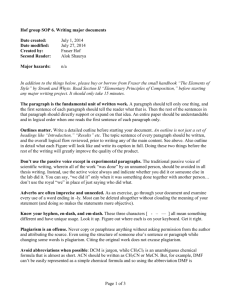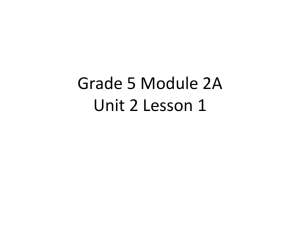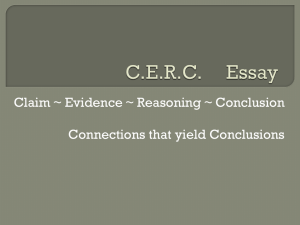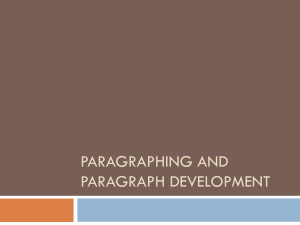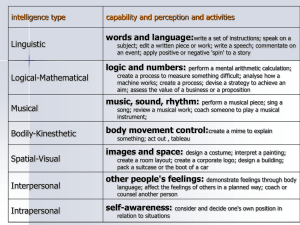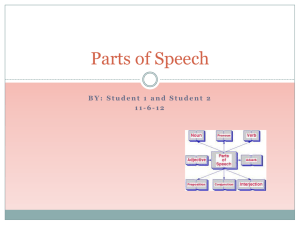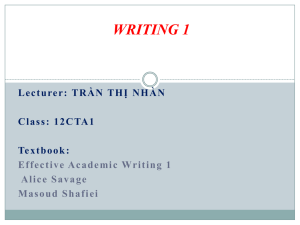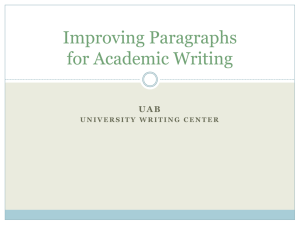纳米结构体系物理化学性质的理论研究方法与实例
advertisement
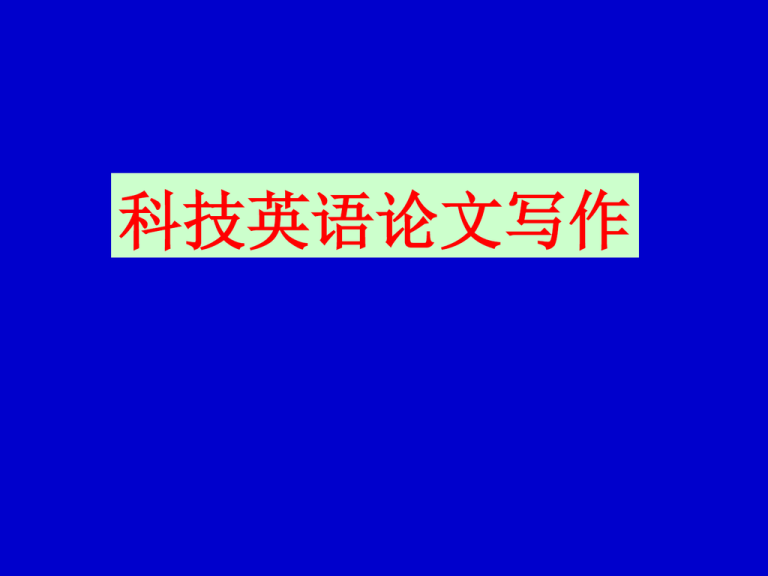
科技英语论文写作 化学论文写作 发表论文是顺利毕业并获得学位的必要条件 (但不是充分条件),自己要负责。 有些学生论文给导师修改后,就坐在电脑前 把导师修改的改上去,然后再拿给导师修改,而自 己不去想为什么应该这样改?作为研究生(而不是 打字员),你要从导师的修改中学习,融会贯通, 为己所用。 • 文章不是数据的堆砌,如果说原来的数据是珍珠 的话,那么写文章就是用线和珍珠来创造工艺品 ,而线就是我们的提纲,不要东一榔头,西一棒 槌,要根据列好的提纲,每天一部分有针对性的 来写会轻松一点。 • 在读文献的时候,特别是沿着一条固定的思路下 去读了许多文献之后,有机会出现新的火花和思 如泉涌的情形。但是,过了之后,就容易把它们 忘记了。读书笔记 。 关于作者以及署名 作者要对文章负责。 Plagiarism(剽窃) To plagiarize is to give the impression that something you have written is your own when it was in fact taken from someone else’s work. Plagiarism may take the form of : • repeating another’s sentences as your own. • adopting a particularly good phrase as your own. • paraphrasing someone else’s argument. • Presenting someone else’s form of organization as your own. In the West, plagiarism is considered a serious academic crime and may lead to expulsion from the university. You’ll never be accused of plagiarism by following these guidelines: • Use your own words and sentence structures. • When putting someone else’s idea in your own words, avoid using any words from the original. • If you use any original words, use a quotation. • Acknowledge all ideas taken from other writers, except commonly held knowledge in the field. It is plagiarism to use some original words or phrases from a sentence while changing others. It is also plagiarism to keep the sentence structure and change all the words to synonyms. Reference Books • 《英语写作指导》,乔治•波特温著,上海 外语教育出版社 • 《科技英语写作教程》,秦荻辉编著,西 安电子科技大学出版社 • 《实用英语写作新捷径》,叶云屏等编著, 国防工业出版社 Chapter 20 科技英语论文写作 20.1 Introduction • 英语写作大致涉及两方面: 第一为语言基础, 即词法句法的正确使用, 要写 出语法上正确的句子(Correct Sentences), 以保 证读者能看明白, 避免Chinese English(Chinglish); 第二要努力写出地道的句子(standard sentences), 即合理地使用专业中的词汇及固定的或特定 的用法. 20.2学术论文语言基本特征 • 准确: 指词汇、句法结构、拼写、标点等 语言要素的正确运用。 • 确切:在语言和内容上都必须准确切实, 恰如其分地反映客观事物的真实面目。 • 简洁:语言干净利落、凝练精悍,避免拗 口的长句和冗长繁杂的修饰语。 • 完整:内容和结构上要求完整、全面而具 体,正确处理完整和简洁的关系。 • 清楚:文章要力求清楚易懂,针对不同的 读者群来决定文章中专业术语的使用比重。 • 客观性:科学论文的语句中,应尽可能以 研究客体作为主语,以求体现客观性。因 此,在描述研究过程时,当动作主体为研 究者本人时,仍常常使用被动语态。 20.3 paragraph(段落) Construction of a paragraph • Usually a paragraph includes a topic sentence (主题句), one or several supporting sentences (论证句) and, sometimes, a concluding sentence (结论 句). Three Qualities of a Paragraph: * Unity(一致性): A paragraph follows a straight line of development; it states a single thought. All material not directly related to the paragraph should be left out. * Continuity(连贯性): All sentences within a paragraph should be arranged logically and smoothly. An outline (提纲) will help you organize your ideas so that all important ideas are included and in logical order, and help you write more quickly. * Transition Signals(转折词) are words to guide the reader and make it easy to follow the ideas. They also help the paragraph flow more smoothly. Classes of Transition Signals • Example(举例): for example, for instance, as an illustration, to illustrate, namely, that is, for one thing. • Addition(增补): in addition, furthermore, moreover, and, also, or, too, besides, again, what’s more, likewise. • Emphasis(强调): in fact, as a matter of fact, in other words, of course, certainly, above all, indeed, clearly, surely, in particular, obviously, naturally, anyway, in this case. Classes of Transition Signals • Contrast(对照): while, whereas, in contrast, on the other hand, instead, on the contrary, inspite of, despite, but, however, although, still, yet, nevertheless, conversely, otherwise. • Comparison(比较): similarly, in the same way, even though, at the same time, not only…but also, likewise, meanwhile. • Concession(让步): although, after all, it is true(that). • Conclusion(结论): in conclusion, to conclude, to sum up, to summarize, in summary, in all, in short, in brief, in a word. Classes of Transition Signals • Cause(原因): for this reason, because of this, because, since, as, for, due to, owing to, thanks to. • Consequence(结果): thus, hence, therefore, accordingly, consequently, so, in this way, as a result. • Order(次序): first, second, first of all, to begin with, at first, finally, eventually, in the end, immediately, soon, in front of, next to, opposite to, in the middle of, afterward, then. Outline 8. Acknowledgement 9. References Acknowledgment • Acknowledge the funding agencies • Thank individuals References (Very important!!!) • • • • • List references in appropriate format Have recent references if possible Give complete information List appropriate numbers of references Do not list anything that is not referred to! 23 Acknowledgement 王 野 王泉明 教授 教授 The habits include grammar mistakes, colloquialisms, and formatting problems and in most cases prevent a clear understanding of the writer’s ideas. Chinese-English colloquial habits hats, CHECKLIST TO USE BEFORE SUBMITTING A PAPER TO A JOURNAL Have you --------------? (28 items in total) 1 spell checked the whole paper? 2 rewritten your paper at least three times? 3 stopped working on your paper for a day? To see and hear your words better when you look at it again. 4 put your main point into your title? 5 put your most significant findings first? Your gold first? 6 made it easy for readers to tell from your title and your abstract what is new and important about your work? 7 made sure all your verbs and subjects match? Plural verbs have plural subjects? Singular verbs have singular subjects? 8 spelled the same name exactly the same way throughout your paper? NOT “Bragg. . . .Brag” BUT BRAGG every time! 9 asked a friend or a native English speaker to read your paper and tell you what’s confusing or unclear? 10 changed nouns to adjectives when necessary? NOT “three dimension ordered array” BUT “three dimensional ordered array” 11 used active verbs rather than passive verbs as much as possible? NOT “The effects were investigated. . .” BUT “We investigated the effects” 12 found a way to break a sentence that’s much too long (over 4 lines) into two sentences? 13 broken up a paragraph that is way too long into two paragraphs? 14 tried to reduce your paper to its skeleton by making a one page outline of it? Might help you see if your paper is organized in the best possible way! 15 Made all equivalent items look the same? NOT “scheme 1 . . . .Scheme 2” BUT “Scheme 1. . . Scheme 2” 16 removed all contractions, such as “can’t” or “couldn’t”? and changed them to “cannot” or “could not”? 17 checked the columns of numbers in your Tables and made all the decimal points in the same column line up vertically? 18 put a noun right after “this” or “these” every time you use one of those words? 19 moved “however” away from the beginning of sentences to a spot later in a sentence where it sounds better? 20 made all your abbreviations the same? NOT 48 hrs 3 hours 2 h five h BUT 48 h 3 h 2 h 5 h 21 used strong definite words? NOT “We have been interested in” BUT “We have focused on” 22 used parallel wording where you lead your readers to expect it? NOT “not only for fabricating. .but also for reduction” BUT “not only for fabricating. . .but also for reducing. . .” OR “not only for the formation of. . .but also for the elimination of. . “ Don’t mix words ending in “ing” with “ion” words. 23 proofread your paper 3 times? At least! 24 read your paper aloud to yourself? 25 Did you use “later” when you meant “latter”? 26 looked for fruit in your figure captions? A fig is a fruit you can eat, but “Fig.” is the correct abbreviation for “Figure.” Don’t forget the period in the abbreviation. 27 proofread your references? Made sure that a journal title, no matter how often it occurs, is always spelled the same way? 28 followed the reference format for the journal you are submitting to? 谢谢同学们! 祝同学们考试顺利! The End

